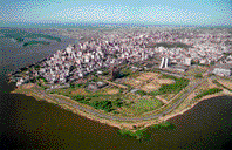|

Date of sister city agreement: March
20, 1967
Population: 1,500,000
Area: 497 square kilometers
Porto Alegre, the state capital
of Rio Grande do Sul in Brazil, is located by the Great Guaiba
Lake. Its hills, parks, squares, and sidewalks change colors with
each of the four well-defined seasons. Hot and humid during the
summer, the temperature sometimes goes below zero in the winter.
The history of Porto Alegre dates back
to 1752, when a group of 60 couples from the Portugese Azores
Islands began building huts by the Guaiba Lake. Later, Germans
came to settle in the region and the city developed commercially,
with factories and extensive agriculture. Due to its vast pastures,
present-day Porto Alegre produces tobacco and raises much livestock.
It is also home to other successful industries such as foodstuff,
wool, and metal-working.
Porto Alegre is the third-ranking Brazilian
city in international trade. LACADOR, a bronze statue representing
the "gaucho" farmer dressed up in his typical work clothes,
serves as a welcome symbol for all the city's visitors and sunset
over the Guaiba is the pride and joy of the gauchos. Open doors
and warm welcomes are the oldest customs in the land which is
called Porto Alegre, "Happy Harbor."
|
|

